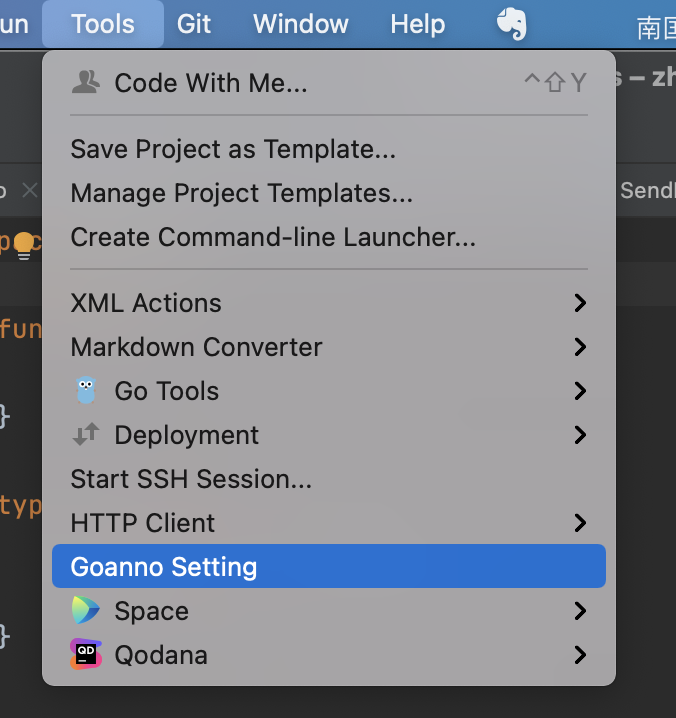最近在学习go语言,以此记录日常编码中的最佳实践,欢迎大家一起讨论
注释模板
使用Goanno插件:https://github.com/loveinsky100/goanno
设置模板
以goland为例
- 选择“工具-Goanno设置”

- 编辑模板
// ${function_name} ${todo}
// @receiver ${receiver}
// @param ${params}
// @return ${return_types}
案例
// GetNode 获取指定结构,从缓存加载
//
// @receiver c
// @param ctx
// @param countryCode 国家码
// @return *Node
func (c *Cache) GetNode(ctx context.Context, countryCode string) *Node, error {
...
return cacheNode, nil
}
日志打印
建议使用zap的零内存分配api,性能比go标准库的api好:GitHub - uber-go/zap: Blazing fast, structured, leveled logging in Go.
格式处理
- %v: 根据值的类型自动选择合适的格式输出。
- %+v: 类似 %v,但会输出更多的信息,如字段名称。
- %#v: 输出值的完整 Go 语法表示,包括类型信息。
- 不要直接打印byte[]类型等无实际意义的日志,应该转成string打印。
错误处理
go最受争议的部分之一就是错误处理,这里不去讨论其好坏,仍然推荐大家使用官方的处理方式:返回error接口,不建议使用panic + recover,容易导致程序崩溃
func f() error {
if ... {
return errors.New("xxx")
}
return nil
}
解决error无堆栈
部分goer建议使用panic + recover就是因为其有堆栈而error没有,但我们可以实现新的error接口时增加堆栈记录
type BizError struct {
code string
message string
cause error
stacktrace struct {
onCreate *stacktrace
onPanic *stacktrace
}
}
// NewBizError create a new BizError
// - cause can be nil is no underlying error
// - omitStacks indicates how many frames should be dropped, if <=0 no stacks will be filled
func NewBizError(code api.ResultCode, message string, cause error, omitStacks int, throwInPlace bool) *BizError {
err := &BizError{
code: code.Code(),
message: message,
cause: cause,
}
if omitStacks >= 0 {
err.stacktrace.onCreate = dumpStacktrace(omitStacks + 1)
if throwInPlace {
err.stacktrace.onPanic = err.stacktrace.onCreate
}
}
return err
}
func (this *BizError) Error() string {
if len(this.message) > 0 {
return this.code + ": " + this.message
} else {
return this.code + ": [NO_MESSAGE]"
}
}
type stacktrace struct {
header []byte // goroutine header (e.g., "goroutine 3 [running]:")
frames []byte // the stacktrace details
}
func dumpStacktrace(skip int) *stacktrace {
skip += 2 // skip debug.Stack and this frame
skip *= 2 // 2-line each frame
stack := debug.Stack()
var header []byte
for i, b := range stack { // assumes no unicode in stack, iterate on bytes
if b == '\n' {
if header == nil {
// consume first line as goroutine header
header = stack[:i]
} else {
skip--
if skip == 0 {
stack = stack[i:]
break
}
}
}
}
if skip > 0 {
panic("skip overflow")
}
return &stacktrace{header, stack}
}
这样使用时即可记录堆栈
类型转换
因为 Golang 语言是强类型,所以经常会使用到类型转换,所以在这里推荐类型转换三方库:GitHub - spf13/cast: safe and easy casting from one type to another in Go
cast.ToString("mayonegg") // "mayonegg"
cast.ToString(8) // "8"
cast.ToString(8.31) // "8.31"
cast.ToString([]byte("one time")) // "one time"
cast.ToString(nil) // ""
var foo interface{} = "one more time"
cast.ToString(foo) // "one more time"
cast.ToInt(8) // 8
cast.ToInt(8.31) // 8
cast.ToInt("8") // 8
cast.ToInt(true) // 1
cast.ToInt(false) // 0
var eight interface{} = 8
cast.ToInt(eight) // 8
cast.ToInt(nil) // 0
json工具
golang原生对json已经做了很好的支持,简单易用,但其性能一直为人垢病,因此建议使用字节开源的工具sonic。除了能平替原生的json使用姿势外,在性能上面也是从底层方面做了很多文章进行优化,性能方面遥遥领先:sonic:基于 JIT 技术的开源全场景高性能 JSON 库_原生云_火山引擎开发者社区_InfoQ写作社区
web/rpc服务
单独为某个下游接口设置超时时间
要知道go的超时时间不像java那样每个调用都固定超时时间,而是以总体时间来计算,但有时部分下游就是需要超出原超时时间进行(当然必须是异步调用,否则就自相矛盾了),具体代码如下:
// 注意:必须先cancel再设置,否则只能设置比原来时间更短的时间
func TestTimeout(t *testing.T) {
ctx := context.Background()
ctx, _ = context.WithTimeout(ctx, time.Second*3)
ctx, _ = context.WithTimeout(ctx, time.Second*6)
deadline, _ := ctx.Deadline()
fmt.Println(deadline.Sub(time.Now())) // 2.99s, 直接覆盖设置不生效
ctx, _ = context.WithTimeout(ctx, time.Second*1)
deadline, _ = ctx.Deadline()
fmt.Println(deadline.Sub(time.Now())) // 0.99s 设置更短时间, 生效
ctx = context.WithoutCancel(ctx) // 取消
ctx, _ = context.WithTimeout(ctx, time.Second*6) // 重新设置
deadline, _ = ctx.Deadline()
fmt.Println(deadline.Sub(time.Now())) // 5.99s, 取消后再设置, 才生效
}
proto参数校验
建议使用PGV:GitHub - bufbuild/protoc-gen-validate: Protocol Buffer Validation - Being replaced by github.com/bufbuild/protovalidate
这样会再生成一个proto的validate文件

建议consumer在远程调用前先调用validate方法,当参数不合法时提前感知
func remote(ctx context.Context) {
request := ...
if err := request.ValidateAll(); err != nil {
return nil, errors.New(err.Error())
}
remoteClient.GetXXX(ctx, request)
}
provider在实现时也必须调用validate,防止参数不合法
func (s *server) Remote(ctx context.Context, request XXX) Response, error {
if err := request.ValidateAll(); err != nil {
return nil, errors.New(err.Error())
}
// 处理逻辑
}
但每个方法都要加validate重复代码,有没有办法统一处理参数校验呢,当然是有的
type validator interface {
ValidateAll() error
}
// ValidateAllInterceptor
//
// @Description: grpc服务注册的参数校验拦截器
// @return grpc.UnaryServerInterceptor
func ValidateAllInterceptor() grpc.UnaryServerInterceptor {
return func(ctx context.Context, req interface{}, info *grpc.UnaryServerInfo, handler grpc.UnaryHandler) (reply interface{}, err error) {
if v, ok := req.(validator); ok {
if err := v.ValidateAll(); err != nil {
return nil, err
}
}
return handler(ctx, req)
}
}
版权归原作者 sunny8zhou 所有, 如有侵权,请联系我们删除。